SEASONS AND WEATHER
Chino is characterized by piercingly cold winters and crisp heavenly summers.
Although the region is mostly known for its winters and summers, its springs and autumns possess a delicate beauty that is just as charming.
In winter, a thick layer of frost covers every exposed surface, but it rarely snows, and the strikingly deep blue sky is often free of any clouds. The cool, dry summers attract multitudes of people who seek refuge from the heat of the cities.
ELEVATION
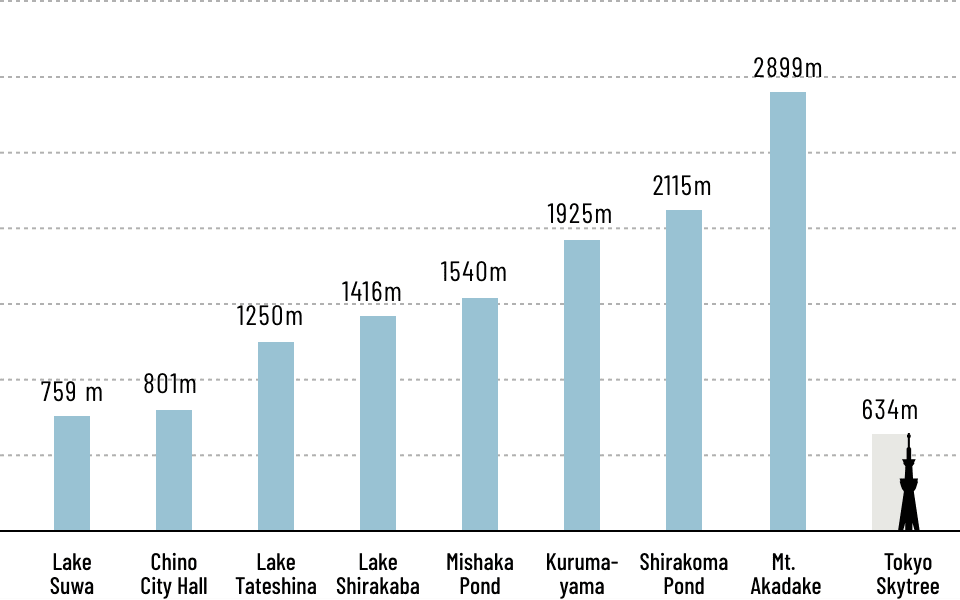

The Chino area is perched in the foothills of a massive mountain range named Yatsugatake. That means even its lowest points stand at over 700m of elevation.
Inside Chino City, the elevation goes from 759 to 2899m, where it culminates in the peak of Mt. Akadake.
The downtown area lies at about 800m, while the rural area spreads from 900 to over 1,000m, and the resort area extends further to 1,900m. The highest elevations, between 2,000 to 3,000m, are occupied by the forests and rocky cliffs of the proper mountain area.
WEATHER
Due to the high elevation, temperatures in Chino tend to be significantly lower than the nearby area throughout the year. Also, the difference in elevation means that there is a considerable temperature gap between lower and higher regions. For example, at the same moment in time, it could be 10℃ at Chino Station and 0℃ at the top of Kurumayama.
In winter, temperatures more often than not drop below zero. During November to April, big sections of mountain roads such as the Venus Line and the Marchen Road are closed to traffic, and even on regular roads, it is mandatory to have snow tires.
Average Temperature


Data from Japan Meteorological Agency
*The temperatures above refer to an elevation of 760m. Please be aware that at higher elevations, the temperatures are going to be 5~10 degrees lower.
What to wear
SPRING (April - June)
- Weather
- In March, it is still winter. Snow resorts may stay open until the first week of April when late snowfalls are not unheard of. Even in May, people turn on the heating in the morning and in the evening. Cherry blossoms bloom in succession from the lowest to highest place over the course of a month.
- Clothes
- Springs can be quite chilly, especially in the shade or in the morning and evening. It is best to have a light coat you can put on when it gets cold. Of course, sunny days at noon can be quite warm, so we suggest you wear layers to adjust your attire depending on the weather.
Summer (July - August)
- Weather
- The average temperature in July and August fluctuates between 20~25℃. As humidity levels are low and the air is fresh and crisp, air conditioning is rarely needed. Up in the mountains, you can still find snow in June. If you plan to go trekking at the beginning of summer, you should keep an eye on the weather report and be ready for rain.
- Clothes
- Even in the middle of summer, it can be quite chilly early in the morning and late in the evening. It is best to bring a long-sleeved top to keep warm when the sun goes down. Also, many tend to forget that sun rays are stronger at a higher elevation, and it is easier to get sunburnt. Make sure to use sunscreen and to bring a hat and sunglasses to protect from UV rays.
Autumn (September - October)
- Weather
- Autumn starts in September when cooler winds blow, and dragonflies begin roaming around. The end of September and the beginning of October is the rice harvest season, and many farmers gather in the fields to reap the rice plants and hang them to dry. That is also when the first snow falls on top of the Yatsugatake.
- Clothes
- From October onwards, it is best to bring a warm coat. If you plan to get out in the evening, you might also want to prepare an extra something like a scarf or beanie to keep you from getting cold.
Winter (November - March)
- Weather
- From November, temperatures start going below zero. Frost forms on the roads at night, and sometimes there are early snowfalls. If you plan to drive, you need snow tires. In winter, snow rarely falls, but if it piles up, it takes a long time to melt away. During the day, especially under the sun, it can be pleasantly warm, but at night and in the morning, it is piercingly cold.
- Clothes
- Make sure to bring plenty of warm clothes. We suggest you bring a down coat, gloves, and a scarf. Roads, even downtown, get slippery, so it is best if you put on some snow boots or other non-slip shoes. Better to avoid high heels.
| Season | SPRING (April - June) | Summer (July - August) | Autumn (September - October) | Winter (November - March) |
|---|---|---|---|---|
| Weather | In March, it is still winter. Snow resorts may stay open until the first week of April when late snowfalls are not unheard of. Even in May, people turn on the heating in the morning and in the evening. Cherry blossoms bloom in succession from the lowest to highest place for a month. | The average temperature in July and August fluctuates between 20~25℃. As humidity levels are low and the air is fresh and crisp, air conditioning is rarely needed. Up in the mountains, you can still find snow in June. If you plan to go trekking at the beginning of summer, you should keep an eye on the weather report and be ready for rain. | Autumn starts in September when cooler winds start blowing, and dragonflies begin roaming around. The end of September and the beginning of October is the rice harvest season, and many farmers gather in the fields to reap the rice plants and hang them to dry. That is also when the first snow falls on top of the Yatsugatake. | From November, temperatures start going below zero. Frost forms on the roads at night, and sometimes there are early snowfalls. If you plan to drive, you need snow tires. In winter, snow rarely falls, but if it piles up, it takes a long time to melt away. During the day, especially under the sun, it can be pleasantly warm, but at night and in the morning, it is piercingly cold. |
| Clothes | Springs can be quite chilly, especially in the shade or in the morning and evening. It is best to have a light coat you can put on when it gets cold. Of course, sunny days at noon can be quite warm, so we suggest you wear layers so you can adjust your attire depending on the weather. | Even in the middle of summer, it can be quite chilly early in the morning and late in the evening. It is best to bring a long-sleeved top to keep warm when the sun goes down. Also, many tend to forget that sun rays are stronger at a higher elevation, and it is easier to get sunburnt. Make sure to use sunscreen and to bring a hat and sunglasses to protect from UV rays. | From October onwards, it is best to bring a warm coat. If you plan to get out in the evening, you might also want to keep an extra something like a scarf or beanie to keep you from getting cold. | Make sure to bring plenty of warm clothes. We suggest you bring a down coat, gloves, and a scarf. Roads, even downtown, get slippery, so it is best if you put on some snow boots or other non-slip shoes. Better to avoid high heels. |
SEASONS
SPRING
Spring slowly makes its ascent from lower to higher elevations, until it reaches the top of the Yatsugatake around June. You can relish flower blossoming and buds opening up on trees for more than two months by simply moving up toward higher elevations.
-
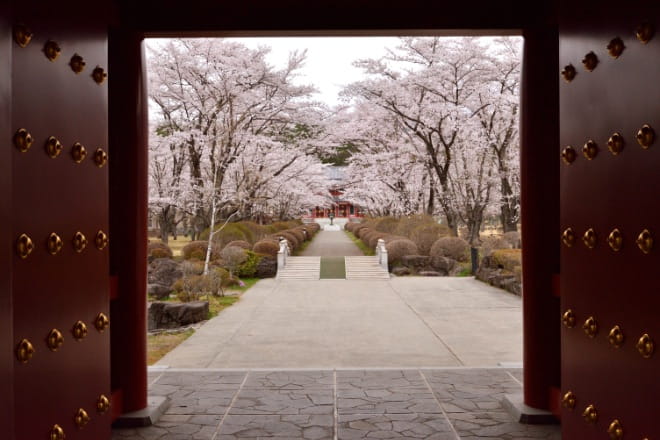
The cherry blossoms at Shoko-ji Temple in Tateshina are among the last to bloom on the island of Honshu. The 300 someyoshino trees reach their peak in early May during the Golden Week holidays.
-
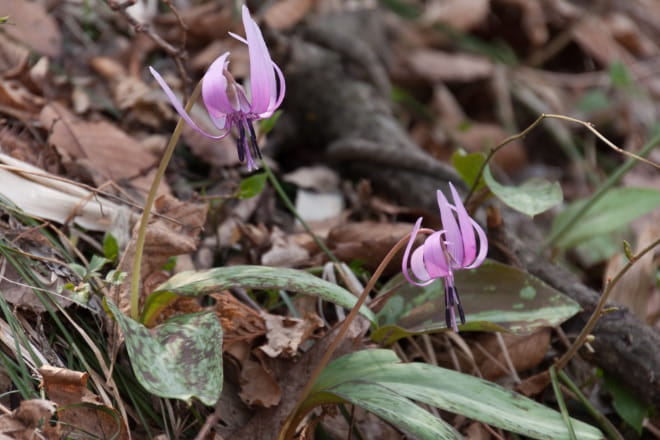
Asian Fawnlilies ("Katakuri" in Japanese) are pink-flowered spring ephemerals that bloom for only two weeks in spring. They are Alpine flowers, but in Chino, they also grow downtown close to the station.
SUMMER
In summer, the scenery turns a deep shade of green, and the mountains are livened by dozens of brightly-colored alpine flowers.
-
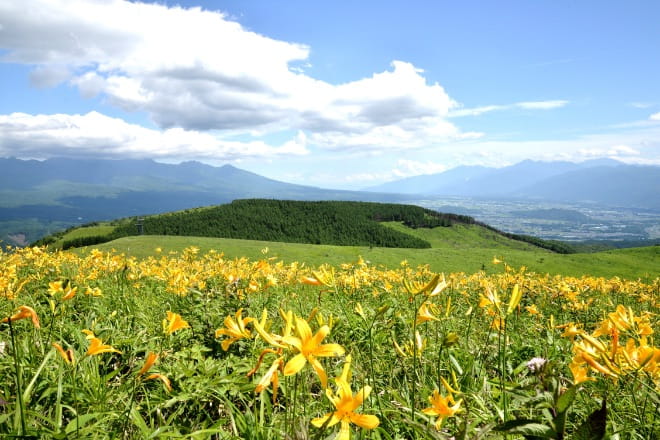
Yellow daylilies ("Nikko-kisuge"), which bloom around July, color up the grassy hills of Kurumayama and Kirigamine Plateau.
-
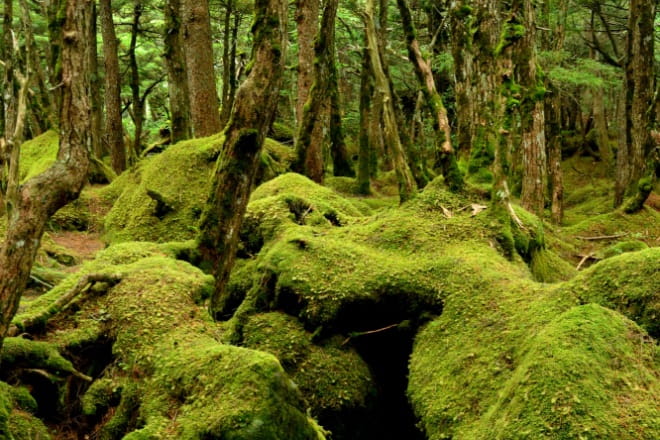
The Moss Forest is a fairytale-like forest in the northern Yatsugatake that looks as if it came out of Hayao Miyazaki’s anime world. The lush emerald moss that covers the entire forest like a fluffy carpet can be seen at its best in the summer months.
AUTUMN
Autumn, like spring but in reverse, slowly descends from the mountain top at over 2,000m to the rural village area. The best spots to view the autumn foliage are Yokoya Valley, Mishaka Pond and Lake Tateshina in the resort area, and Choen-ji Temple in the village area. Kurumayama is also popular in this season for the golden expanse of pampas swaying in the wind.
-
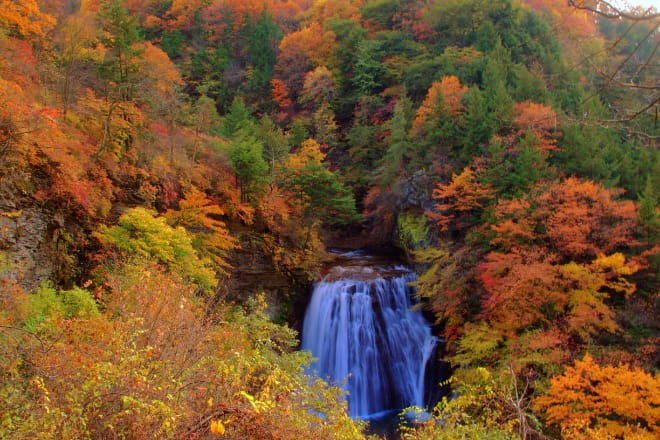
Yokoya is a lush gorge where a 6km trail coasts a river interwoven with waterfalls. Around the beginning of October, the trees turn red, orange, and yellow, creating an artistic whirlwind of colors.
-

Choen-ji is a small village temple that attracts many people in the very first days of November when an autumn foliage corridor of red Momiji and golden Ginkgo leaves usher visitors to the main hall.
WINTER
In winter, frost grips the land in a tight embrace. Waterfall, lakes, and trees freeze, wrapped in a coating of shimmering ice.
-

In the coldest winter months, the northern Yatsugatake is haunted by "Snow Monsters," tall snow-covered trees that almost look like supernatural creatures.
-
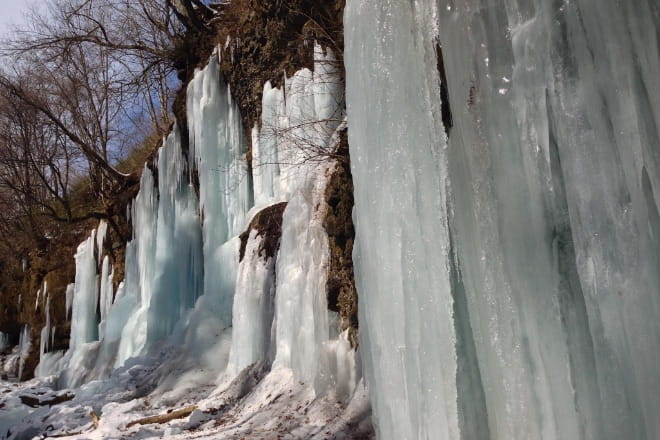
In January and February, Yokoya Gorge waterfalls freeze in place, transforming into icefalls. If you walk through this otherworldly gorge, make sure you have crampons on.

